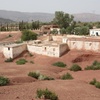Disclaimer
This entry contains information known to us from a variety of sources but may not include all the information currently available. Please be in touch if you notice any inadvertent mistakes in our presentation or have additional knowledge or sources to share. Thank you.
Archive
Shrine of Haim Ben Diwan at Ouirgane, Morocco
A dirt road leads to a compound of buildings enclosed by a gate, overshadowed by mountains and built on rocky terrain in the village of Ouirgane. Inside the shrine are three different tombs, leaving the precise burial spot of Rabbi Haim Ben Diwan, son of the famous Rabbi Amram ben Diwan, in doubt. Two of the graves are identified with markings that appear to indicate it is the final resting spot of Ben Diwan. But which one? The other two are believed to be for two of his disciples. Artifacts, some dating to at least the 1700s, adorn the room, including candlesticks, menorahs, Torah scroll crowns, the Ten Commandments (in Hebrew) etched on a plate, and a flower vase.
Description
Haim ben Diwan: Legend has it that Haim ben Diwan, while traveling the south to continue his father's mission, was followed by unknown people from the mountains who wanted to kill him. Why, or how he knew this, is unclear. What is said is that he went into a cave to avoid capture, which succeeded perhaps too well. Not only did they not find him, but no one has ever found him. Three different tombs are in the shrine leaving the precise burial spot in doubt.
Amram ben Diwan: Amram ben Diwan is one of the best-known saints in the pantheon of Moroccan Jewish holy men. According to tradition, he was a rabbinical emissary from Hebron, who arrived in Morocco with his son, Haim (alternate spelling: Ḥayyim), sometime in the 18th century and took up residence in Fez. When Haim fell gravely ill, Rabbi Amram prayed, offering his life for that of his son, who miraculously recovered. Shortly thereafter, while on a visit to Ouezzane to collect funds for the religious institutions in Hebron, he fell ill and died and was buried in the nearby cemetery of Asjen, which became a pilgrimage destination for Jews from all over Morocco. There is no cenotaph or gravestone marking the tomb, only a cairn of stones. One of the miracles attributed to the site is that all attempts to erect a monument have ended in failure.
Hillula of Rabbi Amram: The ceremony commemorating the anniversary of Rabbi Amram’s death, his hillula (the Hebrew word for wedding, so called because the saint is seen as having wed the Divine), takes place on the holiday of Lag B’Omer, which falls thirty-three days after the beginning of Passover. It still draws large numbers of Moroccan Jews both from within the country and from abroad, including from Israel. A huge bonfire is lit directly on top of the pile of stones marking the grave, and people caught up in religious enthusiasm sometime jump through the flames. Miraculous cures are said to have taken place during the hillula. In Sefrou and Meknes, Jews who could not make the pilgrimage to Asjen invoked Rabbi Amram at local substitute shrines (a sacred cave in Sefrou and a cairn in the cemetery of Meknes). Muslims from the region also sometimes invoke the Jewish saint’s aid in curing illness or infertility.
Suggested Further Reading:
- "Folktales of the Jews, Volume 3: Tales from Arab Lands" by Dr. Dan Ben-Amos
- "Saint Veneration Among the Jews in Morocco" by Issachar Ben-Ami
Sources
Stillman, Norman A. Encyclopedia of Jews in the Islamic World. s.v. "Amram ben Diwan." Accessed July 21, 2014 http://0-referenceworks.brillonline.com.luna.wellesley.edu/entries/encyclopedia-of-jews-in-the-islamic-world/amram-ben-diwan-SIM_0001880










